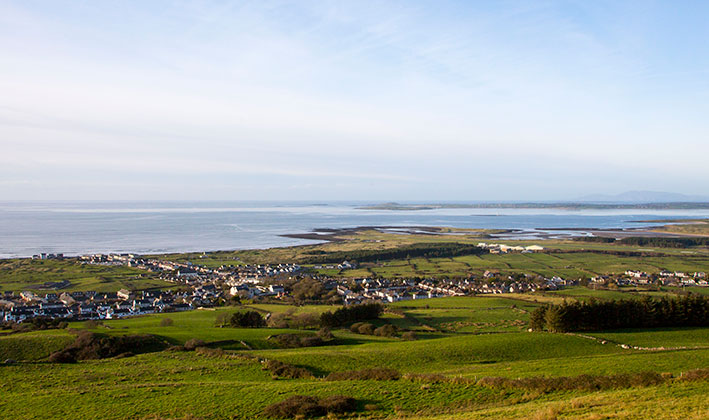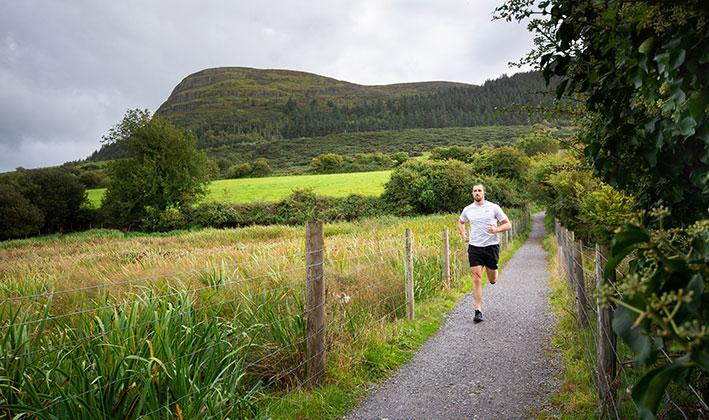Thatched cottages used to be common in Larass. Dolly Higgins’ thatched cottage has been there since at least 1837. It housed three generations of the Bruen family, the first, Andrew Bruen, having been born in the 1840s. Dolly’s Cottage was a rambling house where neighbours used to call for a chat. Now it is home to the Irish Countrywomen’s Association (ICA) who have preserved it as a folk museum with the original open fireplace and furnishings, where locally-made handcrafts are displayed.
If you climb the Queen Maeve Trail up the mountain opposite the Rugby Club you will pass by on the right the ruined remains of Tom (‘Tom the Thatcher’) Gilligan’s once-thatched cottage. He repaired the thatch on Dolly’s Cottage when it was first taken over by the ICA.
Seventeenth-century documents record a castle or fort at Larass. In 1843, Strandhill’s first national school opened there and, about 50 years later, the two earliest hotels. The two-storey house beside Bree’s pub was originally Michael Bree’s Strandhill Hotel until the 1950s and the two-storey house just north of the pub was The Knocknarea Hotel, built by Patrick Ballantine in the late 19th century. It closed when he built the Atlantic Hotel on Buenos Ayres Drive in 1910. They marked the beginnings of Strandhill as a seaside resort.
Just past Bree’s pub you can turn left down the lane known as The Line to the seashore at Cummeen Strand. You will see to the right the high stone wall that enclosed the ruined Strandhill House, once home to the land-owning Meredith family. Thomas Meredith, who settled in the tall house at the shore on Coney Island in 1788, used to drive a yellow coach, dressed in gold-braided coats, across Cummeen Strand on his way to Sligo. Horse races were held on this strand as well as at Culleenamore beach.
In 1891, Charles Stuart Parnell, the leader of the Irish National Party, which sought self-rule for Ireland, crossed from Rosses Point via Coney Island on his way to Strandhill while campaigning in a bye-election. The ‘king’ of Coney Island, Bryan Ward, greeted him and promised him the island’s 29 votes.
The old road from Ballisodare to Sligo ran along the shore at Cummeen Strand and Rinn, rising to higher ground at Cartron townland, before a new road was built in 1836. From there the boats from Sligo port, where many local people worked, and the Black Rock lighthouse, could be seen.
To the left are the remains of one of Strandhill’s first seaweed baths, near where Strandhill was originally located. At Doonagleeragh Point is the two-storey house called Walker’s Lodge, an old hunting lodge of the Walker family of Rathcarrick, now restored as a private dwelling. People from Coney Island used to carry coffins across the strand near there for burial in Killaspugbrone graveyard. You can follow the Killaspugbrone Loop from Cummeen Strand to Killaspugbrone Early Christian church and graveyard, which stands like a sentinel on the headland.
FROM HERE YOU CAN:
- Call in to Dolly’s Cottage to see the open fireplace, original furnishings and the display of locally-made handcrafts.
- Climb the path up the front of Knocknarea and take in the stunning views along the way.
- Walk down the old road past Bree’s pub and turn left down The Line. At the shore turn left and follow the Killaspugbrone Loop to the Early Christian church and graveyard, standing like a sentinel on the headland.
Take happy memories with you but leave no litter and respect the ancient monuments. Watch out for other walkers and traffic.













